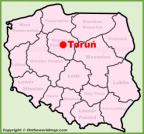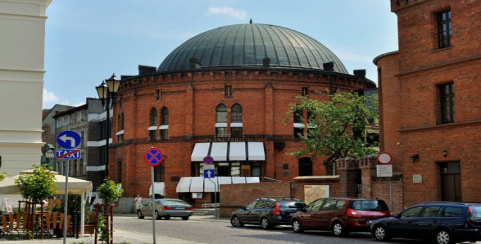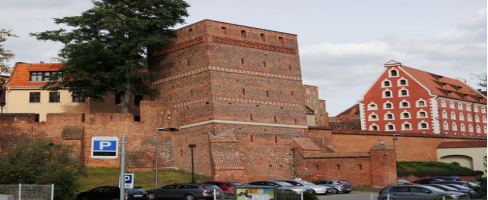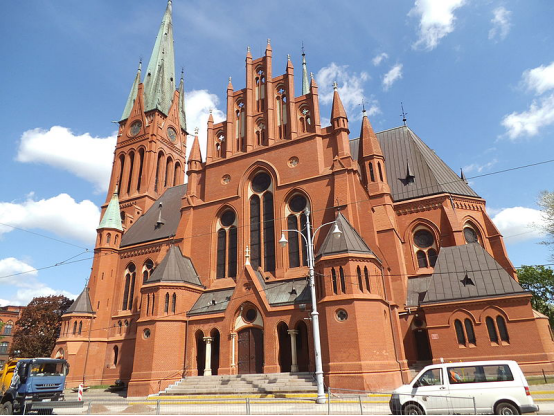Toruń- Kuyavian 作者: 来源: 发布时间:2021-03-08
Ⅰ. Population and Area
Population (31 December 2019)
City 201,447 Decrease (15th)
Metro 297,646
Area
City 115.75 km2 (44.69 sq mi)
Website http://www.torun.pl/

Ⅱ.Natural Geography (environment and resources)
Toruńis a city in northern Poland, on the Vistula River. Background The medieval old town of Toruń is a birthplace of Nicolaus Copernicus.

Transport
The transport network in the city has undergone major development in recent years. The partial completion of ring road (East and South), the completion of the second bridge (2013) and various road, and cycling lane improvements, including construction of Trasa Średnicowa, have decidedly improved the traffic in the city. However, noise barriers that have been erected along the new or refurbished roads have been criticised as not conducive to a beautiful urban landscape. The extensive roadworks have also drawn attention to the declining population numbers, casting doubt that the city might over-delivered for the future number of road users, as the demographic trends forecast from Statistics Poland predicts a reduction of population by almost 1/4 by year 2050.
The city's public transport system comprises five tram lines and about 40 bus routes, covering the city and some of the neighboring communities.
Toruń is situated at a major road junction, one of the most important in Poland. The A1 highway reaches Toruń, and a southern beltway surrounds the city. Besides these, the European route E75 and a number of domestic roads (numbered 10, 15, and 80) run through the city.
With three main railway stations, the city is a major rail junction, with two important lines crossing there (Warszawa–Bydgoszcz and Wrocław–Olsztyn). Two other lines stem from Toruń, toward Malbork and Sierpc.
The rail connection with Bydgoszcz is run under a name "BiT City" as a "metropolitan rail". Its main purpose is to allow traveling between and within these cities using one ticket. A joint venture of Toruń, Bydgoszcz, Solec Kujawski and the voivodeship, it is considered as important in integrating Bydgoszcz-Toruń metropolitan area. A major modernization of BiT City railroute, as well as a purchase of completely new vehicles to serve the line, is planned for 2008 and 2009. Technically, it will allow to travel between Toruń-East and Bydgoszcz-Airport stations at a speed of 120 km/h (75 mph) in a time of approximately half an hour. In a few years' time "BiT City" will be integrated with local transportation systems of Toruń and Bydgoszcz, thus creating a uniform metropolitan transportation network – with all necessary funds having been secured in 2008.
Since September 2008, the "one-ticket" solution has been introduced also as regards a rail connection with Włocławek, as a "regional ticket". The same is planned for connection with Grudziądz.
Two bus depots serve to connect the city with other towns and cities in Poland.
As of 2008, a small sport airfield exists in Toruń; however, a modernization of the airport is seriously considered with a number of investors interested in it. Independently of this, Bydgoszcz Ignacy Jan Paderewski Airport, located about 50 kilometres (31 miles) from Toruń city centre, serves the whole Bydgoszcz-Toruń metropolitan area, with a number of regular flights to European cities.

Ⅲ.Economy
Although a medium-sized city, Toruń is the site of the headquarters of some of the largest companies in Poland, or at least of their subsidiaries. The official unemployment rate, as of September 2008, is 5.4%.
In 2006, construction of new plants owned by Sharp Corporation and other companies of mainly Japanese origin has started in the neighboring community of Łysomice - about 10 kilometres (6 miles) from city centre. The facilities under construction are located in a newly created special economic zone. As a result of cooperation of the companies mentioned above, a vast high-tech complex is to be constructed in the next few years, providing as many as 10,000 jobs (a prediction for 2010) at the cost of about 450 million euros. As of 2008, the creation of another special economic zone is being considered, this time inside city limits.
In recent years Toruń has been a site of intense building construction investments, mainly residential and in its transportation network. The latter has been possible partly due to the use of European Union funds assigned for new member states. Toruń city county generates by far the highest number of new dwellings built each year among all Kuyavian-Pomeranian counties, both relative to its population as well as in absolute values. It has led to almost complete rebuilding of some districts. As of 2008, many major constructions are either under development or are to be launched soon - the value of some of them exceeding 100 million euros. They include a new speedway stadium, major shopping and entertainment centres, a commercial complex popularly called a "New Centre of Toruń", a music theater, a centre of contemporary art, hotels, office buildings, facilities for the Nicolaus Copernicus University, roads and tram routes, sewage and fresh water delivery systems, residential projects, the possibility of a new bridge over the Vistula, and more. Construction of the A1 motorway and the BiT City fast metropolitan railway also directly affects the city. About 25,000 local firms are registered in Toruń.
Ⅳ.Industrial Characteristics
The major industries produce precision instruments, electrical equipment, textiles, and fertilizers. It grew around a castle founded in 1231 by the Teutonic Knights. A flourishing trade center, it was a member of the Hanseatic League (14th–16th cent.).
Key Project
1. XXVII Welconomy Forum in Toruń will take place on september 14-15, 2020.
Welconomy forum in Toruń - Home https://welconomy.pl/home
2. Toruń (PL) - A social economy, designed by millennials 2019URBACT Programme
Toruń (PL) - A social economy, designed by millennials http://www.citego.org/bdf_fiche-document-1952_en.html
3.Tourism
Thanks to its architectural heritage Toruń is visited by more than 1.5 million tourists a year (1.6 million in 2007). This makes tourism an important branch of the local economy, although time spent in the city by individual tourists or the number of hotels, which can serve them, are still not considered satisfactory. Major investments in renovation of the city's monuments, building new hotels (including high-standard ones), improvement in promotion, as well as launching new cultural and scientific events and facilities, give very good prospects for Toruń's tourism.
Ⅴ.Attrations and Cityscape

Toruń planetarium

City walls and the Leaning Tower

Saint Catherine of Alexandria church in Toruń – a perfect example of Toruń's Gothic Revival architecture
Listed on the UNESCO list of World Heritage Sites since 1997, Toruń has many monuments of architecture dating back to the Middle Ages. The city is famous for having preserved almost intact its medieval spatial layout and many Gothic buildings, all built from brick, including monumental churches, the Town Hall and many burgher houses. The most interesting monuments are:
Gothic architecture
Toruń has the largest number of preserved Gothic houses in Poland, many with Gothic wall paintings or wood-beam ceilings from the 16th to the 18th centuries.
The Cathedral of SS. John the Evangelist and John the Baptist, an aisled hall church built in the 14th century and extended in the 15th century; outstanding Gothic sculptures and paintings inside (Moses, St. Mary Magdalene, gravestone of Johann von Soest), Renaissance and Baroque epitaphs and altars (among them the epitaph of Copernicus from 1580), as well as the Tuba Dei, the largest medieval church bell in Poland and one of the largest in Europe
St. Mary's church, a formerly Franciscan aisled hall built in the 14th century
St. James's church (often mistakenly called St Jacob's), a basilica from the 14th century, with monumental wall paintings and Gothic stalls
The Old Town Hall was inaugurated in 1274, than extended and rebuilt between 1391 and 1399, and extended again at the end of the 16th century; considered one of the most monumental town halls in Central Europe (Toruń Regional Museum or Muzeum Okręgowe in Polish)
City fortifications, begun in the 13th century, extended between the 14th and 15th centuries, mostly demolished in the 19th century, but partially preserved with a few city gates and watchtowers (among them the so-called Leaning Tower) from the Vistula side. See also: Toruń Fortress
A 15th-century Gothic house (now a museum) where Copernicus was reputedly born
Ruins of 13th-century Teutonic Knights' castle
House at the sign of the Star (Polish: Kamienica Pod Gwiazdą, the East Asian Museum), previously Gothic, briefly owned by Filip Callimachus, then rebuilt in the 16th century and in 1697, with a richly decorated stucco façade and wooden spiral stairs.
Toruń, unlike many other historic cities in Poland, escaped substantial destruction in World War II. Particularly left intact was the Old Town, all of whose important architectural monuments are originals, not reconstructions.
Major renovation projects have been undertaken in recent years to improve the condition and external presentation of the Old Town. Besides the renovation of various buildings, projects such as the reconstruction of the pavement of the streets and squares (reversing them to their historical appearance), and the introduction of new plants, trees and objects of 'small architecture', are underway.
Numerous buildings and other constructions, including the city walls along the boulevard, are illuminated at night, creating an impressive effect - probably unique among Polish cities with respect to the size of Toruń's Old Town and the scale of the illumination project itself.
Toruń is also home to the Zoo and Botanical Garden opened in 1965 and 1797 respectively and is one of the city's popular tourist attractions.
Ⅵ.History and Culture
The first settlement in the vicinity of Toruń is dated by archaeologists to 1100 BC (Lusatin culture). During early medieval times, in the 7th through 13th centuries, it was the location of an old Slavonic settlement, at a ford in the Vistula river.
fter the Second Partition of Poland in 1793, the city was annexed by Prussia. It was briefly regained by Poles as part of the Duchy of Warsaw in years 1807–1815, even serving as the temporary capital in April and May 1809. In 1809 Toruń was successfully defended by the Poles against the Austrians. After being re-annexed by Prussia in 1815, Toruń was subjected to Germanization and became a strong center of Polish resistance against such policies. New Polish institutions were established, such as Towarzystwo Naukowe w Toruniu (Toruń Scientific Society), a major Polish institution in the Prussian Partition of Poland, founded in 1875. In 1976 it was awarded the Commander's Cross with Star of the Order of Polonia Restituta, one of highest Polish decorations.
After World War I, Poland declared independence and regained control over the city. In interwar Poland Toruń was capital of the Pomeranian Voivodeship. During World War II, Germans occupied the city from 7 September 1939 to 1 February 1945. Local people were subjected to arrests, expulsions, slave labor and executions, especially the Polish elites as part of the Intelligenzaktion. From 1940 to 1943, in the northern part of the city there was a German transit camp Umsiedlungslager Thorn for Poles expelled from Toruń and the surrounding area, which became infamous for inhuman sanitary conditions. Over 12,000 Poles passed through the camp, and around 1,000 died there, including about 400 children. Despite this, the city fortunately avoided damage during both World Wars, thanks to which it retained its historic architecture ranging from Gothic through Renaissance and Baroque to the 19th and 20th century styles.
Toruń is home to a planetarium (located downtown) and an astronomical observatory (located in nearby community of Piwnice). The latter boasts the largest radio telescope in Central Europe with a diameter of 32 m (104.99 ft), second only to the Effelsberg 100 m (328.08 ft) radio telescope.
Toruń is well known for Toruń gingerbread, a type of piernik often made in elaborate molds. Muzeum Piernika in Toruń is Europe's only museum dedicated to gingerbread. The 15-year-old composer Fryderyk Chopin was smitten with Toruń gingerbread when he visited his godfather, Fryderyk Skarbek, there in the summer of 1825.
Toruń is a center of conservative Roman Catholic culture. Redemptorist Tadeusz Rydzyk has organized here Radio Maryja, Telewizja Trwam, a college whose students contribute to the mentioned media. Now a museum is being constructed.
Ⅶ.Other Information
Toruń is one of the oldest cities in Poland, with the first settlement dated back to the 8th century and later having been expanded in 1233 by the Teutonic Knights. Over centuries, it was the home for people of diverse backgrounds and religions. From 1264 until 1411 Toruń was part of the Hanseatic League and by the 17th century it was one of the elite trading points, which greatly affected the city's architecture ranging from Brick Gothic to Mannerism and Baroque. In the early-modern age, Toruń was a royal city of Poland and it was one of the four largest cities in the country at the time After the partitions of Poland it was part of Prussia and later the German Empire. After Poland regained independence in 1918, Toruń was reincorporated into Polish territory, and during World War II was spared from bombing and destruction. This allowed the Old Town to be fully preserved with its iconic central marketplace.
Ⅷ.Contact Information
- Mayor Michał Zaleski
- ul. Wały gen. Władysława Sikorskiego 8
- 87-100 Toruńtel. centrala: +48 56 611 87 77
- e-mail: umt@um.torun.pl
-
